-
Paper Information
- Next Paper
- Previous Paper
- Paper Submission
-
Journal Information
- About This Journal
- Editorial Board
- Current Issue
- Archive
- Author Guidelines
- Contact Us
Software Engineering
p-ISSN: 2162-934X e-ISSN: 2162-8408
2012; 2(4): 165-173
doi: 10.5923/j.se.20120204.10
Mobile Applications Testing Processes Metrics and Optimization Criteria
V. A. Filippov 1, E. E. Khatko 2
1Moscow Institute of Electronics and Mathematics of National Research University a higher School of Economy, Moscow, Russian Federation
2Moscow Institute of Physics and Technology, State University, Moscow, Russian Federation
Correspondence to: V. A. Filippov , Moscow Institute of Electronics and Mathematics of National Research University a higher School of Economy, Moscow, Russian Federation.
| Email: |  |
Copyright © 2012 Scientific & Academic Publishing. All Rights Reserved.
Because of rapid mobile technologies expansion, there is a gap between the complexity of mobile applications and the complexity of employed testing techniques. This paper is aimed at reducing the gap from the theoretical point of view. The paper comprises an analysis of mobile applications testing processes, mobile applications testing metrics, along with the full test coverage criterion. It also contains an integral criterion of the testing processes optimization which is based on the idea of summing the corresponding sub-processes times. The presented criterion leads to an assumption of the tests generation approach efficiency. Therefore a partial criterion of the tests generation process is proposed. The mathematical model of this partial criterion is based on the properties of different algebraic expressions. The numerical results section includes processes comparison and some estimates.
Keywords: Mobile applications, Testing, Tests automation, Tests generation
Cite this paper: V. A. Filippov , E. E. Khatko , "Mobile Applications Testing Processes Metrics and Optimization Criteria", Software Engineering, Vol. 2 No. 4, 2012, pp. 165-173. doi: 10.5923/j.se.20120204.10.
Article Outline
1. Introduction
- In the last few years, mobile technologies have been rapidly expanding in everyday life. Almost every person on earth has a mobile telephone. Mobile devices are becoming more and more complex as new types of devices such as Smart phones, Communicators, Tablets, etc., have appeared. Such devices hardware has configurations similar to yesterday’s desktops’, and thus they should be treated as complex hardware and software systems controlled by operating systems. In the era of conventional phones, testing processes were simple as well. Manual testing processes predominated. However, accelerated evolution of mobile devices leads to formation of a technology gap between the complexity of mobile applications and the complexity of the corresponding testing methods. Manual testing is no longer enough these days. A new complex approach with special test automation tools should come in its place. Therefore the problem of testing methods optimization is very important from the exploratory point of view and urgent from the practical point of view.An analysis of existing testing approaches of mobile applications is presented in the first section of this paper. An iterative scheme is proposed as the most common for mobile applications (MA) development. MA development and testing approaches are formalized based on the iterativescheme.MA testing metrics and the corresponding full test coverage criterion is presented in the second section. Using different algebraic expressions, the third section comprises the mathematical model of the iterative development scheme. A similar model is proposed in (1), but in testing processes are described apart from the development processes. An integral criterion of development and testing processes optimization based on the provided mathematical model is presented in the fourth section. An assumption of test generation techniques efficiency is made based on the presented criterion. This assumption can also be stated from the (2) research which also describes testing processes optimization techniques. But it’s worth mentioning that techniques in (2)are presented in a common way, without providing any mathematical model.The partial criterion of tests generation process efficiency is developed onwards. The test generation problem is presented in (3) and (4). But (3) is circuits domain specific, therefore some specificity of circuits was used, while providing the optimization proposals.(4)provides some basic formal generation approaches with no concern to their optimization.
2. An Analysis of Development and Testing Processes of Mobile Applications
2.1. Analysis of Development Processes
- The process of mobile applications (MA)development is usually performed iteratively (5).This scheme is appropriate for small-scale projects of MA. The peculiarity of this process is in accelerated progress to a released product with several iterations of the full development cycle. The detailed iterative scheme is provided in Figure 2.The cycle of iterations begins after functional requirements are determined. The iterations include the build process, the system testing of new functionality and regression testing. One of the iterations always ends with a decision that the next iteration would be inappropriate. This leads to a new beta version release. In the iterative scheme MA meets testing on a system stage, bypassing the module and integration testing stages. Therefore the MA testing process is usually run on the application UI level.Recently, the MVC (6)architecture has been greatly expanding because of its scalability and simplicity. The following are the definitions of the MVC components in the context of MA testing.Models – data base program inter faces. Models provide the means of data management for the application. To test the application data management processes, one should divide all data accepted by the application into equivalence classes (7)and check the application responses with each class.
 | Figure 1. Different equivalence classes |
 | Figure 2. Detailed iterative process scheme |
2.2. Analysis of Testing Processes
- The following is the detailed iterative process scheme: Figure 2.This figure represents the formal model of the iterative development scheme. Basic development milestones with activities needed for moving between them are presented.In this scheme it’s possible to choose a transition between each process state. The overall application development time depends on the path from the 1st state to the 7thone and on the number of cycles. There are different paths that guide the process from 1 to 7, and each of them defines the corresponding testing method. Let’s consider the most common of these methods.
2.2.1. Manual Documentation, Manual Testing
- 1. Requirements elicitation2. Sketches development 3. Functional specification manual development4. Test cases manual development5. Manual testingThis method is very flexible; it allows achieving any test coverage. But it’s very time consuming. This method will be referred to as the MM method.
2.2.2. Formal modal based Development
- 1. Requirements elicitation2. Formal model development3. Specification generation based on the formal model4. Test cases generation based on the formal model5. Automated testingThis method is simple to automate, but it’s not very flexible in the MA context, because for mal models are not suitable for describing user inter faces. Therefore one can’t reach required testing coverage with tests derived from a formal model. This method won’t be referred toin this paper anymore.
2.2.3. Manual documentation, Automated testing
- 1. Requirements elicitation2. Sketches development3. Functional specification manual development4. Test cases manual development5. Tests automation6. Automated and manual testingTests automation requires textual description fall the actions being automated. Basically, all tests have to be manually developed (as in the MM method) before the automation begins. This method requires a lot of time for tests development at first, but saves time during regression testing later. Therefore this approach is effective when a lot of iterations take place. This method will be referred to as the MA method.
2.2.4. Generated documentation, Manual and Automated Testing
- 1. Requirements elicitation2. Prototype development3. Specification generation based on the prototype4. Test cases generation based on the prototype5. Automated and manual testingProto type sallow describing an application use rinter faces quickly and precisely. Therefore it allows achieving the desired testing coverage. This method also allows generating different types of test cases, if applying special rules for prototype creation. This brings in extra flexibility to the testing process. This method will be referred to as the PR method.
2.3. Analysis of tests Automation Methods
- There are different tests automation tools; in particular some of them are reviewed in (1)and (8).In general, there are two main approaches to tests automation:The program matic automation approach is based on a programming language use, particularly its special libraries. Tests automation is then reduced to programming special modules, classes, and testing scripts. This is a flexible approach, in the sense, that it does not require creating new scripts in case of functionality changes. The playback tools automation approach is based on so called “playback” tools. This approach does not require software engineering skills. Tests auto mation is reduced to running a test on a DUT, but proxy-ing the steps to an appropriate recorder. Recorded tests can be replayed later on a DUT. With this approach, creating a test is basically its execution. The main drawback of this method is that any application change requires recording the test again.
3. Testing metrics of Mobile Applications
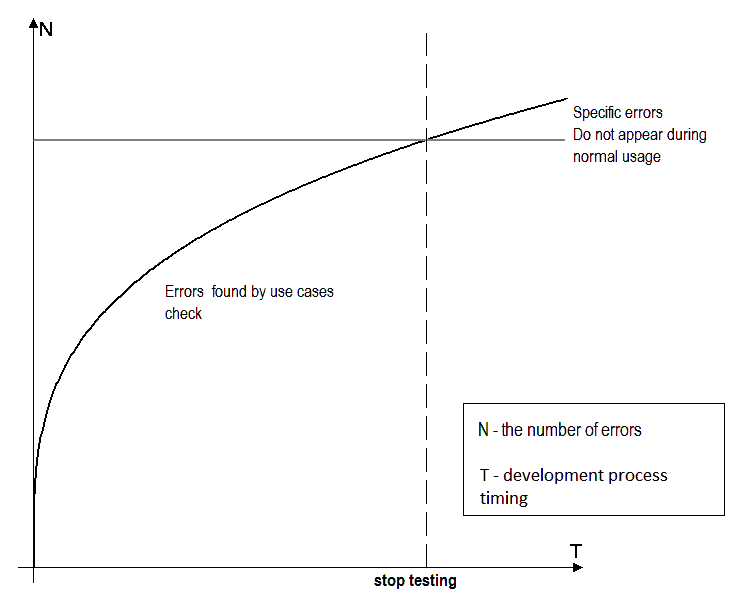 | Figure 3. Testing process ending point |
4. Integral Criterion of Testing Process Efficiency
- Let’s denote the path from state 1 to state 7 in Figure 2as
 . Let
. Let be the time and
be the time and - the coverage, corresponding to
- the coverage, corresponding to  - checked responses. Thereat, time and coverage testing process optimization can be represented as:
- checked responses. Thereat, time and coverage testing process optimization can be represented as: .Since
.Since  is an integer, the expression above can be expressed as:
is an integer, the expression above can be expressed as: | (1) |
 is time spent on the corresponding transition that depends on the applied testing method.
is time spent on the corresponding transition that depends on the applied testing method.  - overall coverage of checked responses.This expression defines an integral criterion of the testing process efficiency and can be used to compare different testing approaches in terms of time and test coverage.Let’s review each summand in the fraction numerator. Let be abstract time corresponding to a time period of the manual requirement creation that describes functionality corresponding to one UI element. Apparently, all summands from the (1) expression except
- overall coverage of checked responses.This expression defines an integral criterion of the testing process efficiency and can be used to compare different testing approaches in terms of time and test coverage.Let’s review each summand in the fraction numerator. Let be abstract time corresponding to a time period of the manual requirement creation that describes functionality corresponding to one UI element. Apparently, all summands from the (1) expression except  depend linearly on
depend linearly on  .
. , because it’s the time period of transfer ring the application to a test house (can be neglected). So far as
, because it’s the time period of transfer ring the application to a test house (can be neglected). So far as  operation should be run once, it can be neglected as well. Let’s consider the following factors that represent summands dependencies on:
operation should be run once, it can be neglected as well. Let’s consider the following factors that represent summands dependencies on: - the model or prototype development factor. Represents relative model or prototype development time per one UI element
- the model or prototype development factor. Represents relative model or prototype development time per one UI element - the specification development factor. Represents relative specification development time per one UI element
- the specification development factor. Represents relative specification development time per one UI element - the implement ation factor. Represents relative implementation time per one UI element
- the implement ation factor. Represents relative implementation time per one UI element - the tests development factor. Represents relative tests development time per one UI element
- the tests development factor. Represents relative tests development time per one UI element - the testing process factor. Represent relative time required to check all use cases correspondent to one UI elementLet
- the testing process factor. Represent relative time required to check all use cases correspondent to one UI elementLet be the number of iterations in the iterative scheme. Let
be the number of iterations in the iterative scheme. Let  be the number of extra responses (the result of built up functional requirements) to check. Let’s sum all of the (1) summands, factoring out the time
be the number of extra responses (the result of built up functional requirements) to check. Let’s sum all of the (1) summands, factoring out the time  , then (1)reduces to:
, then (1)reduces to: | (1.1) |
 -th iteration:1. Implementation time of added function ality is
-th iteration:1. Implementation time of added function ality is times less than implementation time of all functionality (on average).2. Regression testing is always applied to all of the functions, and not only to new ones.Let
times less than implementation time of all functionality (on average).2. Regression testing is always applied to all of the functions, and not only to new ones.Let be the average number of added responses to check during
be the average number of added responses to check during cycles; then let’s convert (1.1), having
cycles; then let’s convert (1.1), having  to:
to: The average number of added responses is negligible compared to all the responses:
The average number of added responses is negligible compared to all the responses:  , compared to
, compared to  then:
then: So the optimization problem can be represented as:
So the optimization problem can be represented as: | (2) |
 factor and the appropriate process should be optimized in the first place, because it’s next to the
factor and the appropriate process should be optimized in the first place, because it’s next to the  factor, and the sum of
factor, and the sum of  and appropriate processes should be optimized in the second place.It’s also worth mentioning that in the case of tests automation the
and appropriate processes should be optimized in the second place.It’s also worth mentioning that in the case of tests automation the -related process should include the processes of manual tests development and automation tests development. And the
-related process should include the processes of manual tests development and automation tests development. And the  - testing process consists of “running tests” and “result estimation” processes.Expression (2) represents quantification of the testing process time consumption, in the case of
- testing process consists of “running tests” and “result estimation” processes.Expression (2) represents quantification of the testing process time consumption, in the case of  iterations of the iterative development process with the coverage of
iterations of the iterative development process with the coverage of  responses to the corresponding functional requirements. When estimating the efficiency of the testing processes it’s safe to neglect the
responses to the corresponding functional requirements. When estimating the efficiency of the testing processes it’s safe to neglect the  summand in expression (2), because it represents the development side of the whole process, but not the testing side.Having carried out a deeper analysis of the reviewed methods the description of which is beyond the scopes of this paper, the following assumptions have been made about the proposed methods and factors:
summand in expression (2), because it represents the development side of the whole process, but not the testing side.Having carried out a deeper analysis of the reviewed methods the description of which is beyond the scopes of this paper, the following assumptions have been made about the proposed methods and factors: 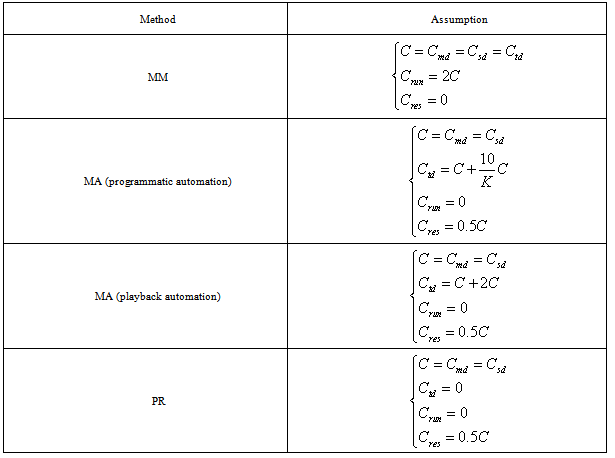 Testing processes efficiency is the ratio of the MM process time and the given process time:
Testing processes efficiency is the ratio of the MM process time and the given process time: , where
, where  is assumed for estimation purposes.
is assumed for estimation purposes. The efficiency then will be expressed as:
The efficiency then will be expressed as: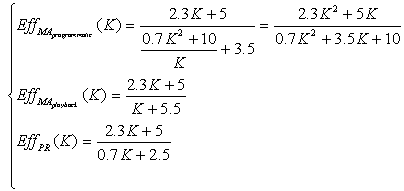 | (2.1) |
5. Partial Criterion of Generation Process Efficiency
- The efficiency of the PR method may be assumed from the result of integral criterion review. The base of the PR method is an effective tests generation technique. To be able to generate tests, one should develop an application prototype, based on appropriate rules(9), extract an EFSM (extended finite state machine) from the prototypeand represent this EFSM as a graph with parameters and conditions. Generated tests may then be used for manual or automated (programmatic approach) testing. Numerical metrics of the generation technique in this case would be:
 - the number of test cases generated by the algorithm
- the number of test cases generated by the algorithm - the average length of a generated test caseFor a particular technique, both of these parameters depend on the inputted graph of the appropriate EFSM. Let’s consider the graph complexity concept as a numerical representation of “how difficult it is to generate a full coverage test suite” with a particular generation technique for the provided graph. Graph complexity should consider the number of graph nodes, transitions, parameters and conditions. It also should be kept in mind that dynamic graphs (with parameters and conditions) are “more difficult” to traverse. It’s suggested to use an rms expression for the graph complexity and to make use of a numerical factor to increase the priority of parameters and conditions over the number of nodes and transitions:
- the average length of a generated test caseFor a particular technique, both of these parameters depend on the inputted graph of the appropriate EFSM. Let’s consider the graph complexity concept as a numerical representation of “how difficult it is to generate a full coverage test suite” with a particular generation technique for the provided graph. Graph complexity should consider the number of graph nodes, transitions, parameters and conditions. It also should be kept in mind that dynamic graphs (with parameters and conditions) are “more difficult” to traverse. It’s suggested to use an rms expression for the graph complexity and to make use of a numerical factor to increase the priority of parameters and conditions over the number of nodes and transitions:  , where
, where - the number of graph nodes
- the number of graph nodes - the number of graph transitions
- the number of graph transitions - the number of graph conditions
- the number of graph conditions - the number of graph parameters
- the number of graph parameters - the priority factorThen the partial criterion of the generation process will be expressed as:
- the priority factorThen the partial criterion of the generation process will be expressed as: | (3) |
 - the MA prototype’s EFSM graph,
- the MA prototype’s EFSM graph, - complexity of the graph.This figure represents a test generation process. The provided partial criterion (3)measures generation efficiency in context of this process.In fact, the product
- complexity of the graph.This figure represents a test generation process. The provided partial criterion (3)measures generation efficiency in context of this process.In fact, the product  estimates the number of user requests to the application (e.g. button clicks) that should be done to achieve the required coverage. Therefore a lower value of the product corresponds to greater efficiency of the generation technique. The
estimates the number of user requests to the application (e.g. button clicks) that should be done to achieve the required coverage. Therefore a lower value of the product corresponds to greater efficiency of the generation technique. The  in the fraction numerator of (3)normalizes the efficiency value so that it would not be dependent on the graph itself.
in the fraction numerator of (3)normalizes the efficiency value so that it would not be dependent on the graph itself.6. Numerical Results
- Let’s plot the reviewed methods efficiency using the expression
 | (2.1): |
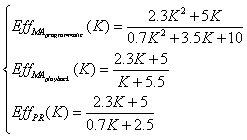
 | Figure 4. Generation process efficiency metrics |
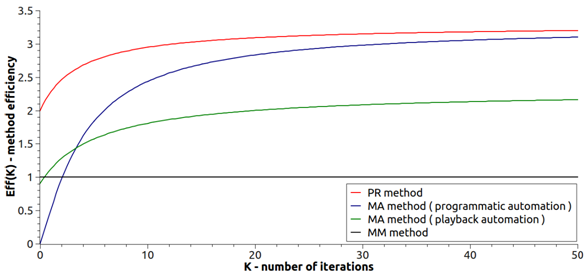 | Figure 5. Testing methods efficiency |
7. Conclusions
- The paper comprises an analysis of mobile applications testing processes, mobile applications testing metrics, along with the full test coverage criterion. It also contains an integral optimization criterion of testing processes which leads to an assumption of a tests generation approach efficiency. Therefore a partial criterion of the tests generation process is proposed. The numerical results section includes processes comparison and proves the taken assumptions.The significance of the proposed integral criterion is in the capability to measure different testing methods integrated into the iterative development process. The significance of the proposed partial criterion is in the capability to measure different tests generation techniques and algorithms based on the graph traversal approach.
 Abstract
Abstract Reference
Reference Full-Text PDF
Full-Text PDF Full-Text HTML
Full-Text HTML